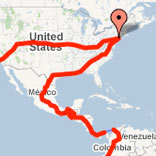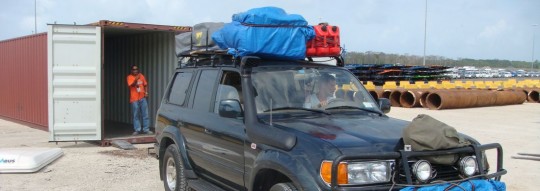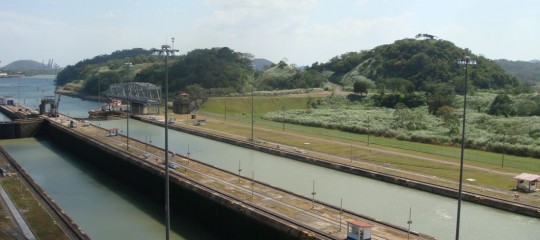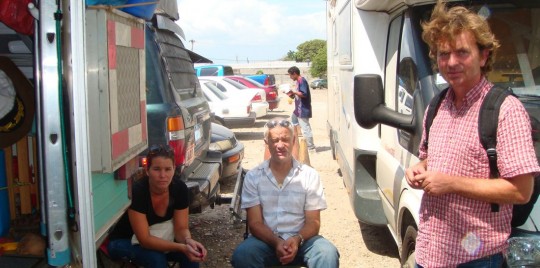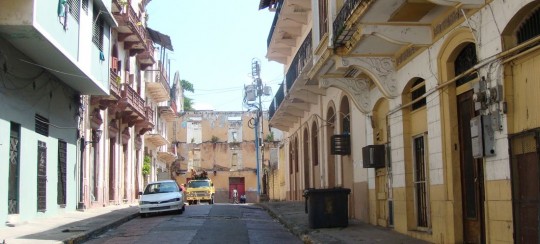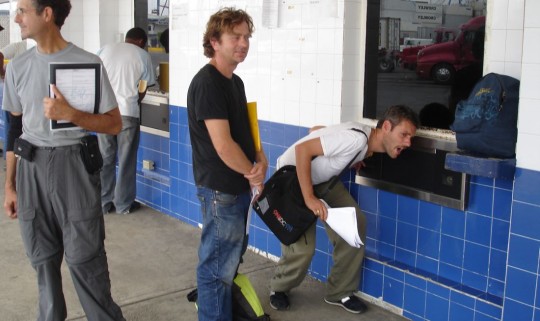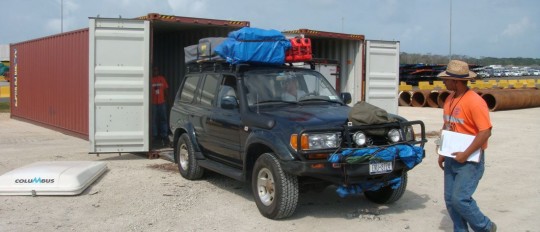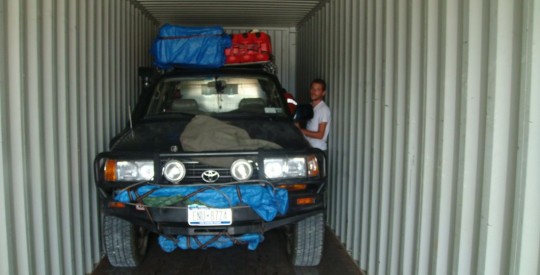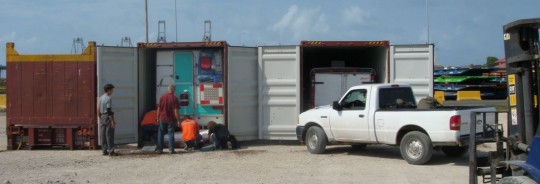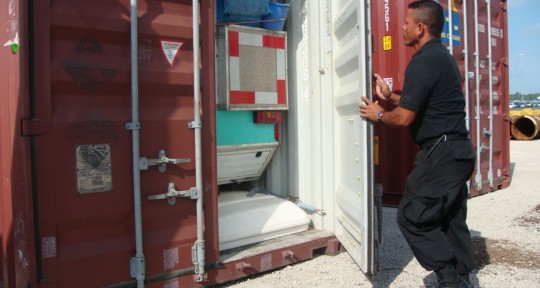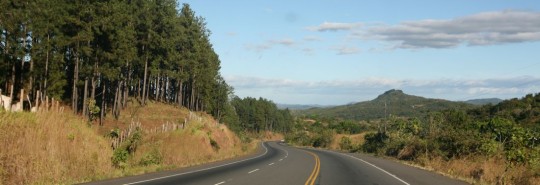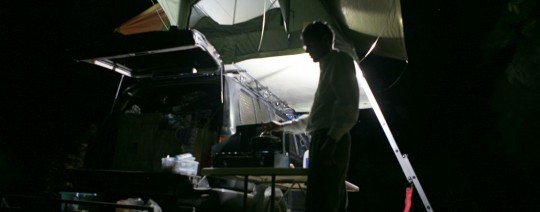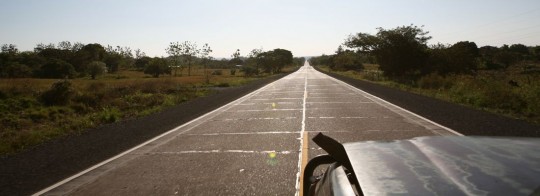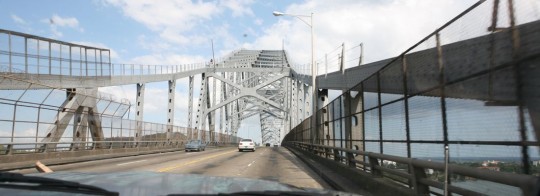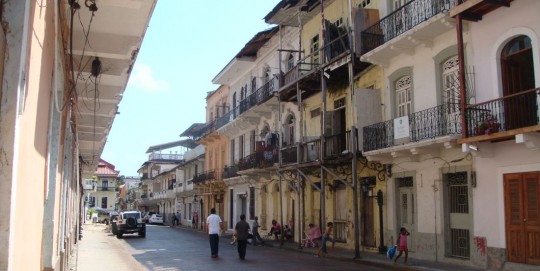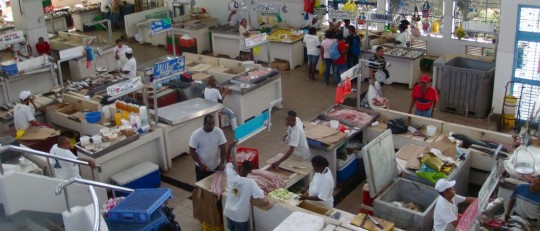- Home
- About Nick
- Maps
- People helping the expedition
- Expenses breakdown
- Truck and equipment (Sept. 16)
-
Packing big trucks in small containers
On Sunday we visited the Miraflores locks on the Panama Canal.Early on Monday morning, we met with the other parties, all French travelers, and we booked two containers and a flat-track to transport the four vehicles. Sharing a 40-feet container with another vehicle, I had to pay US$950, not including fees on the Colombian side.All day Monday was busy running from one police station to the other, filling tons of meaningless papers, always looking for the next stamp. First we needed the inspection of the vehicle, when the police check the truck serial number. Then we had to go to another place where they check that you didn’t get a ticket while in Panama. They then give you an exit authorization. We had to go back to the shipping agent to pay and get the Bill of Lading.The day after, we left the city at sunrise with only one driver per vehicle, since only one person can enter the port with each shipment. It took us one hour to reach Colon, on the Caribbean coast. We stopped shortly before the city to wash the car, as the port authority can have you pay US$100 to clean the vehicle if they judge it too dirty to enter their rusty containers.All the first part of the day went running from the custom offices to the shipping agent, to inspections, to get port entry passes (US$5), and to have drug searches done on the trucks.At last, around 2 p.m., the port employees guided us to our containers. My vehicle, the smallest of all was able to enter without problem in the 2.6-meter-high box. We un-mounted a roof-tent from the other vehicle we stuffed in the same container, and also had to let the air out of the tires so it would fit.In another container, we stuffed without problem a big Dodge truck, but had to force a bit to get the U-Haul trailer in.Another camping car found its place on the flat track.At 3:30 we were out of the harbor and dirty like dogs. We shared a car to the airport where employees would soon understand how bums from the road look like.It was very disappointing to fly above the Darien Gap at night and I will always regret I didn’t see this mysterious place. I bet that in a decade there will be a road there, changing the fragile equilibrium between the jungle and its inhabitants.Nadia flew earlier in the day in another plane to get hotel rooms in Cartagena with other people of the gang ($30 and less for a room). Around 11 p.m. we met her in the city after a 1-hour flight (US$240, could cost $180 in advance, but you need to have your Bill of Lading in hand before you buy your ticket).Two hours and few beers later, we were in bed, exhausted.NOTES:Shipping between Colombia and Panama can cost $750 to $1400 for a big SUV. You can use Ro-Ro (roll-in roll-out boats, a bit like ferries) or containers. There is no ferry service. The most common route is Cartagena-Colon. It takes 2 days to do the paperwork before departure, two days at arrival, and 1-2 days transit time.Another solution I found out too late is that there is a possibility to use banana boats to go from Colombia to Costa Rica (skipping panama). It is also possible to ship from Ecuador to Costa Rica. There are at least a weekly departure for cars between Panama and Colombia with the two most used shipping companies, which are Wilhelmsen and Seaboard. Both companies are similar in prices. All depend of if you ship alone, share containers, and how many containers you will book. You can ask quotes to Vanessa de Gracia(vdegracia [AT] seaboardmarinepanama.com) from Seaboard and Evelyn Batista from Wilhelmsen (Company used to be call Barwil) (evelyn.batista [AT] wilhelmsen.com).For the banana boat, ask a quote and a list of destinations to Alicia from the famous Chiquita company (alromero [AT] chiquita.com). Use the Banana boat only if it is way cheaper.Along with a group of other people shipping trucks, we were able to find a container boat leaving Colon, Panama on Wednesday. We went with Wilhelmsen (http://www.wilhelmsen.com), a worldwide company. If you are interested in shipping your car, there is a note at the end of this entry giving contact information.
On Sunday we visited the Miraflores locks on the Panama Canal.
Early on Monday morning, we met with the other parties, all French travelers, and we booked two containers and a flat-track to transport the four vehicles. Sharing a 40-feet container with another vehicle, I had to pay US$950, not including fees on the Colombian side.
All day Monday was busy running from one police station to the other, filling tons of meaningless papers, always looking for the next stamp. First we needed the inspection of the vehicle, when the police check the truck serial number. Then we had to go to another place where they check that you didn’t get a ticket while in Panama. They then give you an exit authorization. We had to go back to the shipping agent to pay and get the Bill of Lading.
The day after, we left the city at sunrise with only one driver per vehicle, since only one person can enter the port with each shipment. It took us one hour to reach Colon, on the Caribbean coast. We stopped shortly before the city to wash the car, as the port authority can have you pay US$100 to clean the vehicle if they judge it too dirty to enter their rusty containers.
All the first part of the day went running from the custom offices to the shipping agent, to inspections, to get port entry passes (US$5), and to have drug searches done on the trucks.
At last, around 2 p.m., the port employees guided us to our containers. My vehicle, the smallest of all was able to enter without problem in the 2.6-meter-high box. We un-mounted a roof-tent from the other vehicle we stuffed in the same container, and also had to let the air out of the tires so it would fit.
In another container, we stuffed without problem a big Dodge truck, but had to force a bit to get the U-Haul trailer in.
Another camping car found its place on the flat track.
At 3:30 we were out of the harbor and dirty like dogs. We shared a car to the airport where employees would soon understand how bums from the road look like.
It was very disappointing to fly above the Darien Gap at night and I will always regret I didn’t see this mysterious place. I bet that in a decade there will be a road there, changing the fragile equilibrium between the jungle and its inhabitants.
Nadia flew earlier in the day in another plane to get hotel rooms in Cartagena with other people of the gang ($30 and less for a room). Around 11 p.m. we met her in the city after a 1-hour flight (US$240, could cost $180 in advance, but you need to have your Bill of Lading in hand before you buy your ticket).
Two hours and few beers later, we were in bed, exhausted.
Appologies to all for the delay posting this entry, but it seems that in Colombia, access to my blog is blocked by a government program of internet censorship. It may be a problem until I leave the country.
NOTES:
Shipping between Colombia and Panama can cost $750 to $1400 for a SUV. You can use Ro-Ro (roll-in roll-out boats, a bit like ferries) or containers. There is no ferry service. The most common route is Cartagena-Colon. It takes 2 days to do the paperwork before departure, two days at arrival, and 1-2 days transit time.Another solution I found out too late is that there is a possibility to use banana boats to go from Colombia to Costa Rica (skipping panama). It is also possible to ship from Ecuador to Costa Rica. There are at least a weekly departure for cars between Panama and Colombia with the two most used shipping companies, which are Wilhelmsen and Seaboard. Both companies are similar in prices. All depend of if you ship alone, share containers, and how many containers you will book. You can ask quotes to Vanessa de Gracia (vdegracia [AT] seaboardmarinepanama.com) from Seaboard and Evelyn Batista from Wilhelmsen (Company used to be call Barwil) (evelyn.batista [AT] wilhelmsen.com).
For the banana boat, ask a quote and a list of destinations to Alicia from the famous Chiquita company (alromero [AT] chiquita.com). Use the Banana boat only if it is way cheaper. -
Looking for a boat in Panama
We arrived at the border with Panama at around 11:30 in the morning. As usual, kids who want to help jumped on us as soon as we showed up. Tired of it, we let one of them guide us through the complex circuit. As in every border crossing, we cancel the temporary import of the car, get our passports stamped out of Costa Rica, get the visa for Panama (US$2), get car insurance for a month in Panama (US$15) and make the temporary import for the truck (Free).
This time we specify our exit point as being the harbor of Colon, on the Caribbean side. From there we should ship to Cartagena, Colombia.
Two hours later we are done. I buy some duty free merchandise, and we go with the car through fumigation to avoid importing illegal parasites.Once we pass the border, we are at 500 kilometers from the capital and we don’t have enough time to make it before night. It is now Wednesday, and I want to use Thursday and Friday to find a shipping solution for the car.
200 kilometers from Panama City, we leave the Pan-American Highway to take a dirt road so we can find a camping spot. At the end of the path, 20 minutes later, we find a small village with no electricity and ask a family to camp around.Nadia is tired as we took a lot of heat during the border crossing. She goes to bed, and I make diner and read. I am now able to spend a little bit of time with my books since we made it to Costa Rica. Before that, days were so busy I could not keep up with all the reading material I bring along. Recent readings include Jim Harrison “True North” (recommended), Richard Yates collection of short stories “Eleven kinds of loneliness” (recommended), Joseph Heller “Catch 22” (I did not like).
In the morning we wake up very early, thanks to our friends the roosters. Soon, we are back on the road, we find back the Pan-Am and continue our drive east.
Around 1 p.m., we pass the bridge above the Panama Canal. It’s exciting, as I am now getting ready to close the Central America chapter of the expedition.A bit later, we go and visit the first agent who gives us few quotes. I have been shopping around as well in the past, and got some help from a Panamian friend (Thanks Alberto!).
Also, we have been speaking with other travelers who are looking for a ride with their trucks, and we are hoping to get a group price. Basically, it looks like shipping will cost between US$900 to $1,350. That does not account for harbor fees on the Colombian side (an estimated $250).As a reminder, it is impossible to drive from Panama to Colombia, since the Pan-American Highway is interrupted, and there are no roads to cross through the jungle for about 90-miles.
On Friday, I continue my research and speak with other agents. One of the options, which was to ship on a banana boat from Chiquita doesn’t work out. But our luck is that with the economic downturn, it is easier to find container boats with space available.Since we arrived in the city, we camp at the entrance of the Canal, close to the Balboa Yacht Club. Here, we have access to water and internet, which is necessary for all the research I have to do. It is rare that these container boats take passengers, so we also have to book flight tickets (around US$200).
Also, I considered flying from Panama City to Puerto Obaldia, close to the border on the Panama coast. From there, it is possible to hop with speed boats to Colombia and take a bus to reach Cartagena. Unfortunately, the air strip is closed for renovation, and so there is no way to take the cheap (US$65) flight, and have a real look at the Darien Gap.
On Saturday, businesses are closed, so we take the opportunity to go visit Casco Viejo, the historical center of Panama City. We stroll along the old streets, and go to the fish market to have lunch (recommended). Casco Viejo is nice, and invaded by tourists. It is still pleasant, but the small streets get hot. We visit the Panama Canal Museum.Very interesting, but it is important to note that the exhibits are mostly made of long texts in Spanish, with no English translation available.
The first tentative to build the canal was made by France who failed and lost 22,000 men, mostly due to diseases carried by mosquitoes. After a Cuban doctor found how to eradicate them (the mosquitoes, not the French), an American attempt to build the Canal succeeded, and the first boat went through in 1914. Nowadays, there are 15,000 vessels going through every year, and it takes them 10-hours to go all the way.Casco Viejo is also the part of town where you find the cheapest hotels, and we will probably sleep there for a night after the car is in a container sailing to Colombia. After lunch, we go to the fruit market to buy food we will cook later. Then, we go back to our camp site.


